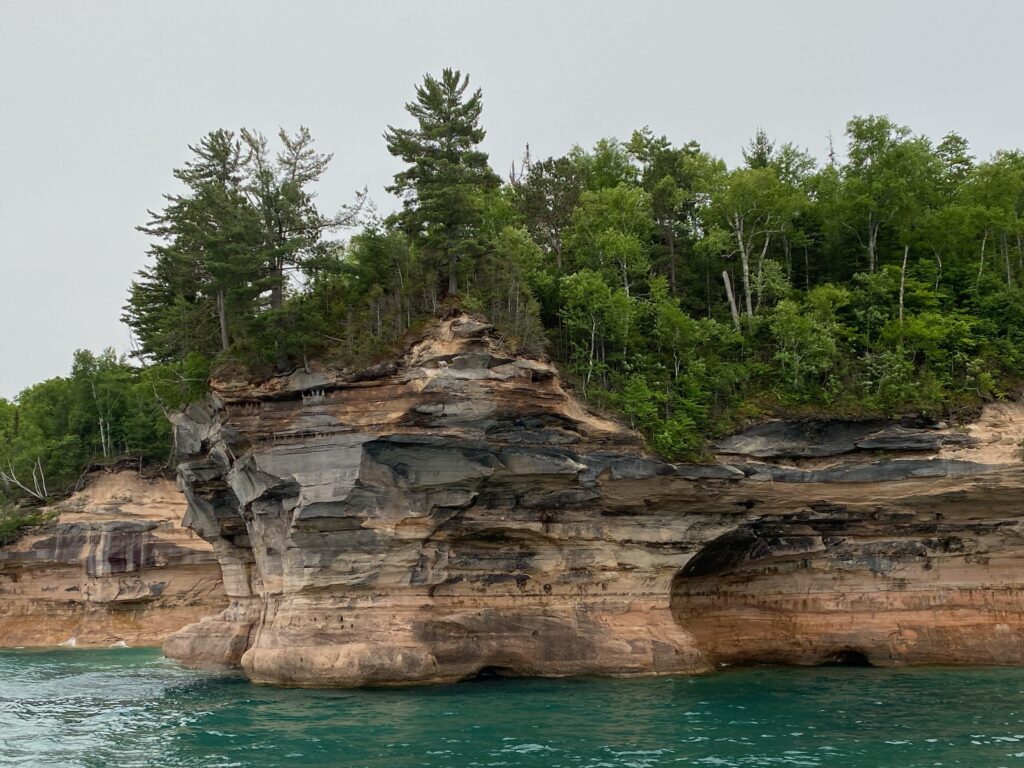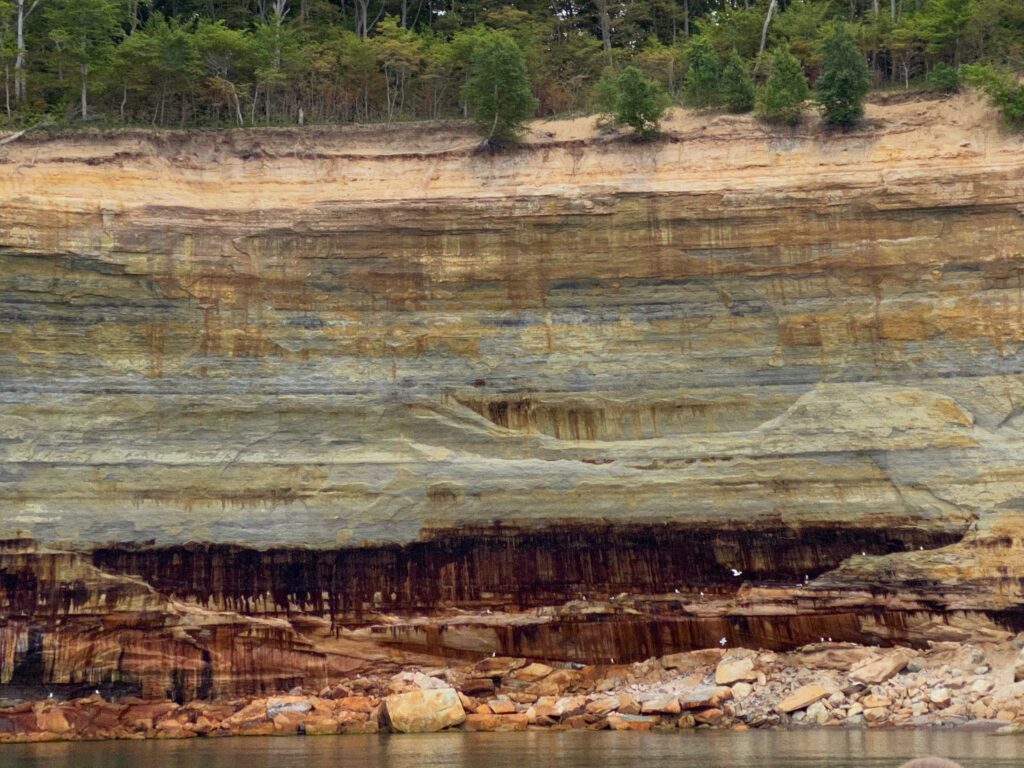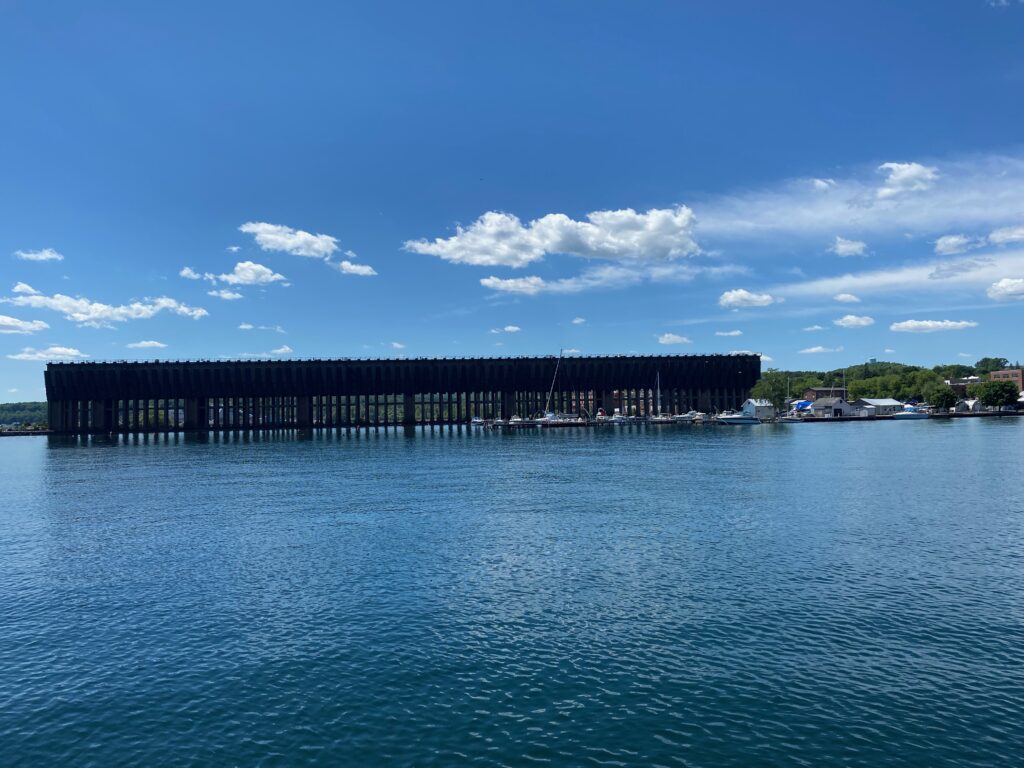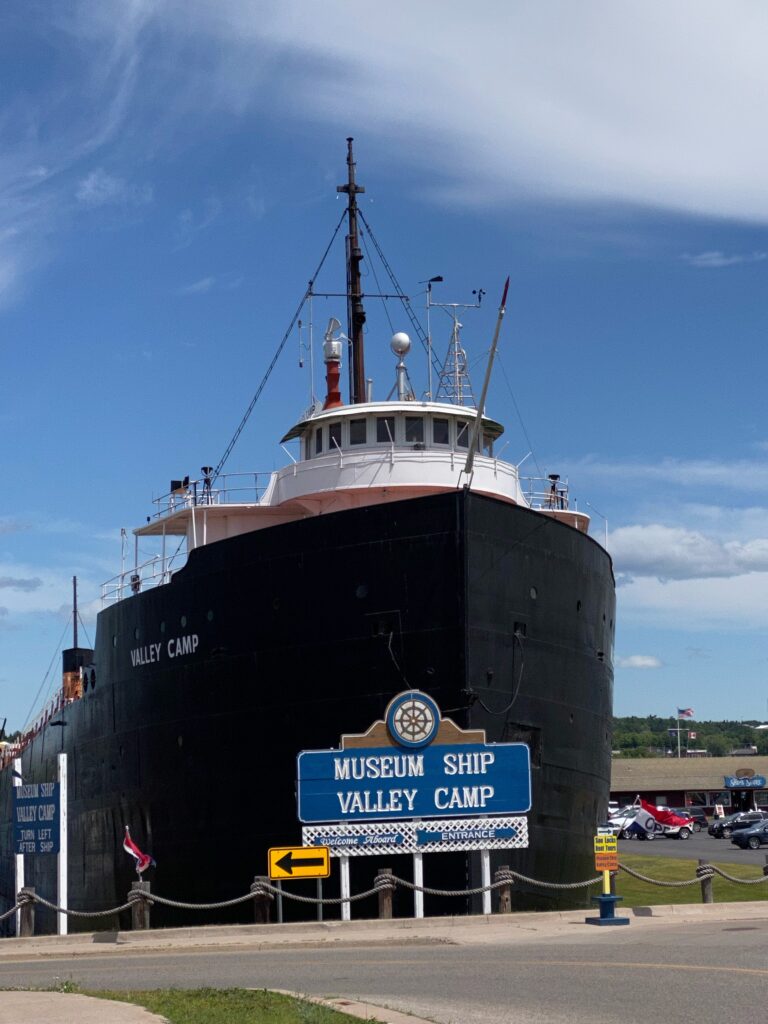Yooperland: June 13-15
“The best thing that could happen to the U.P. would be for someone to bomb the bridge.”
—John Voelker, former Michigan Supreme Court Justice and the author of Anatomy of a Murder and Yooper resident—
Well, I have to say blowing Da Bridge might be a little extreme. Permit me to say the Upper Peninsula of Michigan is unique and it is obvious Yoopers want to keep it that way. Too late. Hordes of tourist are upon them each summer. Nancy and I, flâneries at heart, wanted to discover the U.P. This is what we found:
MARQUETTE
I can correctly pronounce the name of this city; I have read about the French Jesuit missionaries and Jacque Marquette who found the village in the early 17th century. (I decline to credit them with founding the site as Native Americans like the Chippewa were already finding the area quite nice to hang their hats.) Jesuits, trappers and fishermen were followed by the shipyards and miners. Today, it is pretty much tourists.
Marquette not only has a charming old town (rather quiet as per Covid) but a beautiful lake front. The shoreline is blessed with green parks, Harbor Basin, a pier, paths and lake front dining. Not active but historic is its 1911 Ore Dock. The imposing dock, built during the mining boom, is over 1,250 feet long, 60 feet wide and 75 feet high. In its hay-day, Marquette’s docks moved massive tons of ore dug out every day from the Marquette Iron Range and shipped west through Lake Superior into Duluth or east toward the steel mills of Indiana Harbor and around the Great Lakes.
MUNISING
Arriving in Munising, we needed to ask its pronunciation. Found on South Bay and sheltered from the worst of Lake Superior, Munising is a small town or around 2,500 people who have slipped an unassuming second “i” into their city, pronounced “myoo·nuh·suhng.”
The best activity in town is spending time in the Pictured Rocks Interpretive Center enjoying its excellent exhibits, having an ice cream at Miners Pasties and Ice Cream in the patio behind, then embarking on a 2-hour cruise along the Pictured Rocks National Lakeshore.

Pictured Rocks are magnificent sandstone cliffs that get their stripes and splashes of color from the abundance of minerals in the rock. Add water, which Michigan has a plethora of, and you get blue and green (copper), red and orange (iron), brown and black (manganese), and white (limonite). Cliffs tower 50-200 feet above Lake Superior and paint a vibrant picture even Jackson Pollock would love. The entire landscape is topped by forests with trees grasping for purchase, rooting deeply into the cliff’s face. Which, along with the constant flow of water necessary for the colors, and the freezing and thawing of the sandstone, the unexpected can happen. On 29 June, 200 feet of a cliff face plummeted into the lake making for some spectacular video and reminding everyone of nature’s fragility.

There was a similar collapse in 2019 when kayakers escaped injury as a section of cliff peeled off and crashed into Lake Superior. This is a beautiful but rugged area and boaters, hikers and kayakers beware. Having passed Chapel Rock on our way to Spray Falls on smooth-as-glass waters, just 30 minutes later upon our return the seas were extremely choppy and our catamaran stopped to pull two kayakers from the frigid waters. As dear Alex Trebek said: “If you can’t be in awe of Mother Nature there’s something wrong with you.”
We depart this lovely area and drive east though more trees. We did see a deer gingerly cross the road.
SAULT STE. MARIE
The main attraction here are the Soo Locks, which provide our first lesson. The city is pronounced “Soo Saint Mah-Ree.” Our hotel is just perfectly located across from the locks and in the center of Soo Saint Mahree. We parked the car for a couple days and set out to learn about these historic locks and environs.
Soo Locks date back to 1797 when the Northwest Fur Company constructed the first portage between the differing levels (21 feet) of Lake Superior/St Marys River and the other Great Lakes. Massive amounts of shipping, and massive ships, pass down St. Marys River carrying over 90% of the U.S.’s iron ore on their way to feed the commerce in the east. (Passage extends 2,332 miles from Duluth, MN to the Atlantic Ocean taking 7 days.) Locks are free to use (though there is a commercial tonnage fee), thus from the grandstand overlooking the U.S. locks, one can see everything from the 1000-foot Burns Harbor carrying over 80,000 tons of cargo, to small tour boats and even kayakers maneuver their way through the locks. This can be quite a feat for the Burns Harbor which is 105 feet wide squeezing into a lock 110 feet wide. Clearly, the ships cannot experience a “pandemic weight gain” like the rest of us.
The locks on the American and Canadian side of the border are all gravity fed. The Poe Lock is 1,200 feet (built 1968) while the MacArthur Lock is just 800 (built 1943). Two additional locks, Davis and Sabin, are not in use and being redesigned into a new 1000-foot lock. Then there is the wonderful little natural water flow where fish can circumvent the busy canals and any fees.
Visiting the excellent interpretive center and watching the passage of the Burns Harbor was a step back. I lived for many years on the tip of Lake Michigan and am familiar with the steel mills of Gary and Burns Harbor. The experience here was bring names to life for me. There is much to learn about our Great Lakes.
The Great Lakes Shipwreck Historical Society was closed but a visit to the Valley Camp more than made up for it. The cargo ship SS Valley Camp plied the Great Lakes for over 50 years and now rests as an excellent museum along the docks of St Marys River. Over her lifetime she hauled everything from grain to coal and iron ore between the mills of Buffalo, NY to Burns Harbor, IN. Now she proudly hauls dozens of exhibits and one can explore the wood-lined wheelhouse, peek into cabins and kitchen, walk her decks and climb into her massive holds and engine rooms and every other fascinating crany of this ore ship.
However, the most interesting experience is the display and explanation of the tragic sinking of the SS Edmund Fitzgerald which sunk into the deep waters of Lake Superior during a fierce storm on 10 Nov 1975. Many people may be familiar with the disaster because of the folk singer Gordon Lightfoot who wrote and sang “The Wreck of the Edmund Fitzgerald” which can be found on YouTube.
At the time, she was the largest ship sailing the Great Lakes and was on her last voyage of the season when struck by hurricane-force winds, losing both radars and taking on water in 35-foot swells. She sunk, with all 29 sailors, off the coast of Ontario, Canada. She was later found just 17 miles short of the Soo Locks, laying in two pieces at a depth of 535 feet. A part of the exhibition, along with artifacts and history, is an excellent video on the events of the Edmund Fitzgerald.
The ship’s brass bell was recovered 4 July 1995 (a commemorative bell hung in its place). Each year at the Great Lakes Shipwreck Museum where the bell holds a place of honor, the “Call to the Last Watch” tolls 30 times in remembrance of the 29 men who went down with their ship and the 30th toll is for all sailors who have died on the Great Lakes.
Sault Ste. Marie is a pleasant town with the main street cluttered with Yooper shops, Yooper restaurants and Yooper bars. Getting thee to one of its many breweries, one finds mostly sports bar rather than tasting. Getting thee to a restaurant finds not just fried foods but deep-fried. I found it an ignoble end for a noble fish. And towering over most of it is an ugly-ass structure of concrete called the Tower of History.
However, all in all, no matter how the Yoopers pronounce it, Sault Ste. Marie is worth a visit.
And then there is Mackinac. So many recommendations, so many travel articles, so much to learn.







0 Comments